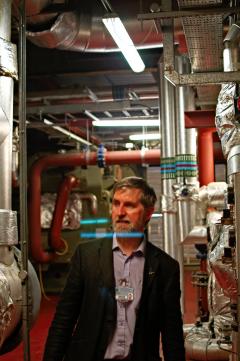Climate change, energy and utilities
The University was a founding signatory to the Universities and Colleges Climate Commitment for Scotland in 2008, and this commitment to harness the University’s expertise to reduce its carbon footprint has been incorporated into the University’s Climate Action Plan 2010-20.
Absolute carbon emissions
This chart shows the upward trend of the University’s emissions and includes emissions across both the academic estate and accommodation services.
Scope 1: Includes direct Greenhouse Gas (GHG) emissions from sources that are owned or controlled by the University such as natural gas combustion and University owned vehicles.
Scope 2: Accounts for GHG emissions from the generation of purchased electricity, heat and steam generated off-site.
Scope 3: Includes emissions from the transmission and distribution of electricity, staff and student commuting. This does not include GHG emissions related to business travel and procurement.
The University accepts its responsibility to ensure it takes forward action on climate change by reducing its direct emissions, and influencing carbon emissions from its indirect operations.
Carbon emissions

Despite progress being made through investment in energy infrastructure, in particular Combined Heat and Power Energy Centres, and other efficiency measures, as well as behaviour change programmes, the University is not on track to achieve its current absolute carbon reduction targets.
The University campus has substantially increased in size due to mergers and new developments, with student numbers growing since targets were set. The University’s relative targets for emissions per square metre of gross internal area, or per pound turnover [see table below] have shown a more positive trend, but the University recognises that it needs to take further action.
Climate Change Strategy
A Climate Change Strategy is being developed and will replace the current Climate Action Plan in 2016. The new strategy will set out revised carbon targets and will identify a number of pathways to achieving significant carbon reductions. With support from the Scottish Funding Council (SFC) we are developing a carbon modelling and scenarios tool; reviewing carbon reduction best practice in the University sector; and developing business cases to support investment in renewables and energy reduction.
Several energy conversion projects have been implemented in 2014/15, including: upgrading existing air handling units; installing demand based ventilation systems; improving heating and cooling controls; and installing photovoltaic solar panels. The University continues to increase the electricity and heat generated on campus through expanding its district heating network.
Saving energy
Further energy efficiency projects are being reviewed for 2015/16 with a heavy emphasis on demand based equipment, such as heating pumps and ventilation fans, as well as prioritising efficiency opportunities through the University’s sustainable laboratories programme.
Sustainable Laboratories
| 06/07 | 07/08 | 08/09 | 09/10 | 10/11 | 11/12 | 12/13 | 13/14 | 14/15 | |
|---|---|---|---|---|---|---|---|---|---|
| Tonnes CO2 per £m turnover | 124 | 139 | 127 | 131 | 136 | 124 | 122 | 112 | 100 |
| Tonnes CO2 per 1000m2 GIA | 99 | 110 | 114 | 126 | 131 | 107 | 111 | 107 | 101 |

